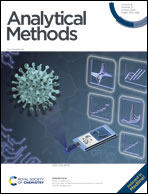A novel fluorescent probe with a large Stokes shift for colorimetric and selective detection of cysteine in water, milk, cucumber, pear and tomato†
Abstract
Cysteine is an important amino acid that is related to human health and food safety. How to effectively detect Cys in food has received widespread attention. Compared with other methods, fluorescent probes have the advantages of simple operation, high sensitivity, and good selectivity. Therefore, a selective fluorescence probe 2 for Cys in food was designed and synthesized. Probe 2 employed the acrylate group as a thiol-recognition site for Cys, which endowed probe 2 with better selectivity for Cys over Hcy and GSH. The recognition pathway underwent Michael addition, intramolecular cyclization, and concomitant release of the piperideine-based fluorophore, along with a chromogenic change from yellow to orange. This pathway was supported by 1H NMR analysis and DFT calculations. In addition, probe 2 displays a linear response to Cys concentrations (0–30 μM), low detection limit (0.89 μM), and large Stokes shift (125 nm). Overall, probe 2 showed great application potential for the quantitative determination of Cys in water, milk, cucumber, pear and tomato.



 Please wait while we load your content...
Please wait while we load your content...